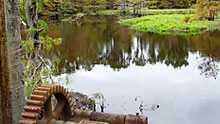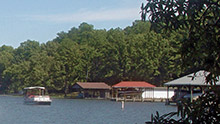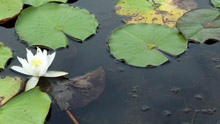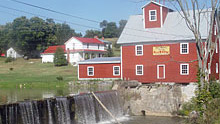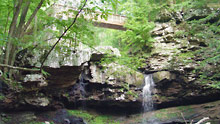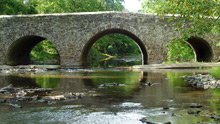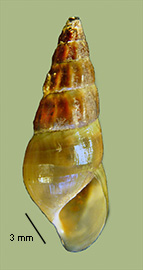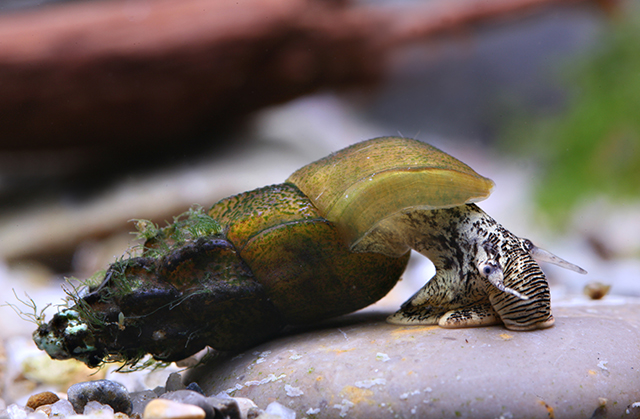Goniobasis or "Elimia" laqueata
> Habitat & Distribution
Goodrich (1940) gave that the range of P. laqueata (in its strict sense) as the Green River and tributaries in Kentucky, tributaries of the Cumberland River in Middle Tennessee, the Duck River and branches, and "tributaries of Tennessee River in Tennessee and Alabama." Our modern surveys would expand that range slightly, to include upper tributaries of the Kentucky River. We would also clarify that P. laqueata does not range upstream in the Tennessee drainage east beyond the vicinity of Chattanooga.
The complete absence of P. laqueata from East Tennessee is one of the most striking results of our entire FWGTN survey. One would think that a freshwater snail ranging 400 km from the middle of Kentucky to North Alabama and 300 km from Paducah to Chattanooga could easily hop Walden Ridge. Might the distribution of Pleurocera laqueata offer us a clue to the orogeny of the Appalachians?
Throughout this striking range, P. laqueata laqueata populations primarily inhabit rocky riffles in small to moderate-sized rivers and streams. Considered together with its big-river form P. laqueata alveare and hybrid P. laqueata castanea, its FWGNA incidence rank is I-5.
> Ecology & Life History
Grazing by populations of pleurocerids can have a significant effect on energy flow in small streams (Dillon 2000: 86 - 91, see also Dillon & Davis 1991).
Like other pleurocerids, P. laqueata is dioecious, eggs being deposited on hard substrates from spring to mid-summer. Eggs are spirally arranged in masses of 2-15 or more, with a tough, membranous outer covering to which sand grains typically adhere (Smith 1980, Jokinen 1992). Although we are unaware of any study specifically directed toward the life history of P. laqueata, it seems reasonable to expect that two years will be required for maturity, and that several years of iteroparous reproduction can be expected thereafter, as is the case for pleurocerids generally (Dazo 1965). This is life cycle Hi of Dillon (2000: 156 - 162).
> Taxonomy & Systematics
This is another North American pleurocerid species demonstrating protean variability in shell morphology, named and re-named dozens of times in the nineteenth and early twentieth centuries. Goodrich (1940) recognized ten valid species and six valid subspecies in his group of Goniobasis laqueata, along with no fewer than 55 synonyms. See my essay of 18Sept24 from the link below for a nice photo of intrapopulation variation in shell plication.
More recently it has become clear that the distinction Goodrich and all previous authorities made between the former genera Pleurocera and Goniobasis (or "Elimia") is due to cryptic phenotypic plasticity (Dillon 2011, 2014; Dillon et al. 2013). This has led to the realization that populations previously identified as "Pleurocera alveare" are likely downstream ecophenotypic morphs of P. laqueata. See my essays of 23Mar11 and 8Aug18 from the links below for more.
In my essay of 15Oct24 I presented shell-morphological evidence of extensive hybridization between P. laqueata and P. troostiana in the rivers and streams of Middle Tennessee, North Alabama, and southern Kentucky. Hybrid populations are traditionally identified as subspecies of P. troostiana: edgariana, perstriata, and lyonii. And in my essay of 12Nov24 I presented evidence of hybridization between P. laqueata and P. simplex, yielding populations identified as P. laqueata castanea, and generalized all these findings across a wide variety of species and regions to suggest reticulate evolution in the North American Pleuroceridae.
Taxonomically, we have suggested that Isaac Lea's (1838ish) nomen troostiana (with its several subspecies) be applied to populations bearing shells with any degree of striation, leaving Thomas Say's (1829) nomen laqueata for populations bearing shells entirely unstriate. Junior synonyms of laqueata include costifera (Haldeman 1841), curreyana (Lea 1841), interveniens (Lea 1862) and plicata-striata (Wetherby 1876). See my essays of 10Dec24 and 14Jan25 from the links below for a complete taxonomic review.
> Maps and Supplementary Resources
- Pleurocera laqueata in the drainage of The Ohio (2019)
- Distribution in the Tennessee/Cumberland (2022)
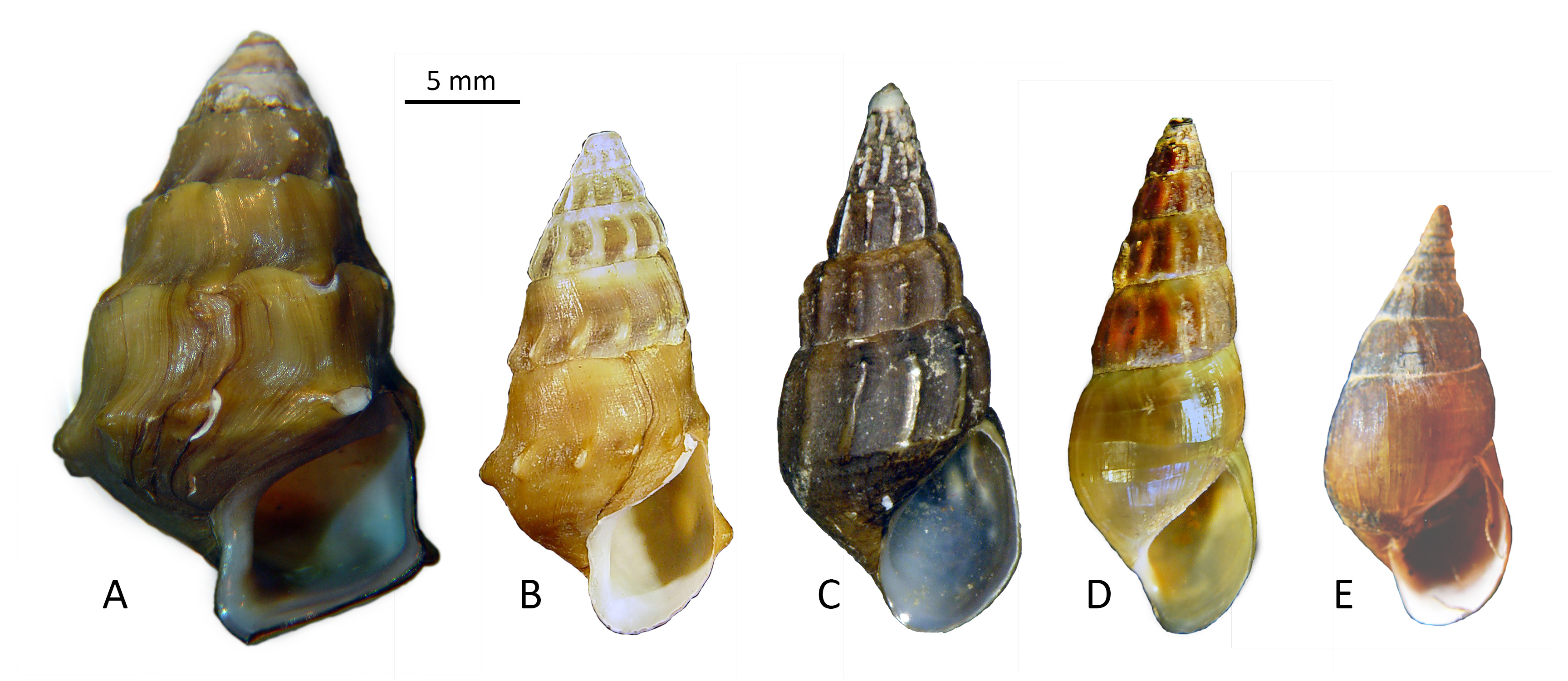
> Essays
- Taxonomic controversy has surrounded the generic nomina Pleurocera, Goniobasis, and Elimia for many years. The best entry into the subject would be my essay of 23Mar11, entitled Goodbye Goniobasis, Farewell Elimia. Links are available from that essay to older resources.
- I reviewed the evidence that P. alveare may be a downstream ecophenotypic morph of P. laqueata in my essay of 8Aug18, Pleurocera alveare: Another case of CPP?
- In my essay of 18Sept24 I restricted The Type Locality of Melania laqueata to Browns Creek in Nashville, TN. That essay also includes a reproduction of Say's original (1829) figure and a nice figure illustrating intrapopulation variance in shell plication in the topotypic population.
- See my essay of 15Oct24 for shell morphometric evidence of Widespread hybridization between P. laqueata and P. troostiana in streams of the Tennessee/Cumberland.
- And in my follow-up essay of 12Nov24, I generalized evidence of hybridization between populations of P. laqueata and both P. troostiana and P. simplex to suggest Reticulate evolution in the North American Pleuroceridae. That November essay also featured additional systematic, taxonomic, and biological backround about P. laqueata castanea.
- Given the extensive three-way hybridization documented in the essays linked above, we should not be surprised to discover that a wonderful tower of taxonomic babel has been erected to capture the rich variety of shell morphological variation associated. See my review of 10Dec24, Taxonomy Part I, for reproductions of the original figures and fresh images of the holotypes for three junior synonyms: costifera (Haldeman 1841), curreyana (Lea 1841) and interveniens (Lea 1862). See Taxonomy Part 2 for a images of a paratype of plicata-striata (Wetherby 1876), as well as an impressive bed of relic P. laqueata shells from a tributary of the East Fork Stones River.
> References
Dazo, B. C. (1965) The
morphology and natural history of Pleurocera
acuta and Goniobasis
livescens (Gastropoda: Cerithiacea: Pleuroceridae).
Malacologia 3: 1 - 80.
Dillon, R. T., Jr. (2000)
The Ecology of Freshwater Molluscs. Cambridge, Cambridge University
Press. 509 pp.
Dillon, R. T., Jr. (2011)
Robust shell phenotype is a local response to stream size in the genus Pleurocera.
Malacologia 53: 265-277. [pdf]
Dillon, R. T.,
Jr. (2014) Cryptic phenotypic plasticity in
populations of the North American freshwater gastropod, Pleurocera semicarinata.
Zoological Studies 53:31. [html] [pdf]
Dillon, R. T. Jr.,
& K. B. Davis (1991)
The diatoms ingested by freshwater snails: temporal, spatial, and
interspecific variation. Hydrobiologia 210: 233-242.
Dillon, R. T., Jr., S. J.
Jacquemin & M. Pyron (2013) Cryptic phenotypic
plasticity in populations of the freshwater prosobranch snail, Pleurocera canaliculata.
Hydrobiologia 709: 117-127. [html] [pdf]
Goodrich, C. (1940)
The Pleuroceridae of the Ohio River drainage system. Occas.
Pprs. Mus. Zool. Univ. Mich., 417: 1-21.
Haldeman. S. S. (1841) A monograph of the
Limniades and other freshwater univalve shells of North America. Volume 2.
Jokinen, E.H. (1992)
The freshwater snails of New York State. New York State Museum
Biological Survey, New York State Museum Bulletin 482.
Lea, Isaac (1838-39) Description of New Freshwater and Land Shells. Transactions of the American Philosophical Society (New Series) 6: 1 154.
Lea, Isaac (1841)
Continuation of Mr. Lea's paper on New Fresh Water and Land
Shells. Proceedings of the American Philosophical Society 2: 11
15.
Lea, Isaac (1843)
Description of New Fresh Water and Land Shells. Transactions of
the American Philosophical Society (New Series) 8: 163 250.
Lea, Isaac (1845) Descriptions of new fresh water and land shells. Proceedings of the American Philosophical Society 4: 162 168.
Lea, Isaac (1848) Description of new fresh water and land shells. Transactions of the American Philosophical Society 10: 67 101.
Lea, Isaac (1862) Description of a new genus (Goniobasis) of
the Family Melanidae and eighty-two new species. Proceedings of the Academy of
Natural Science of Philadelphia 19: 262 272.
Say, T. (1829) Descriptions
of some new terrestrial and fluviatile shells of North America.
New Harmony Disseminator of Useful Knowledge 2(18): 275 277.
Smith, D.G.
(1980) Goniobasis
virginica (Gastropoda: Pleuroceridae) in the Connecticut
River USA. Nautilus 94:50-54.

